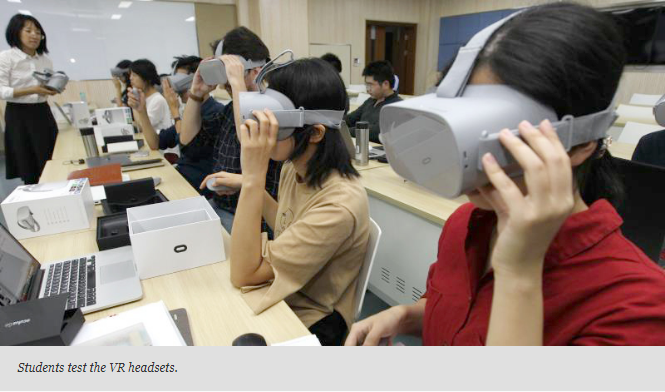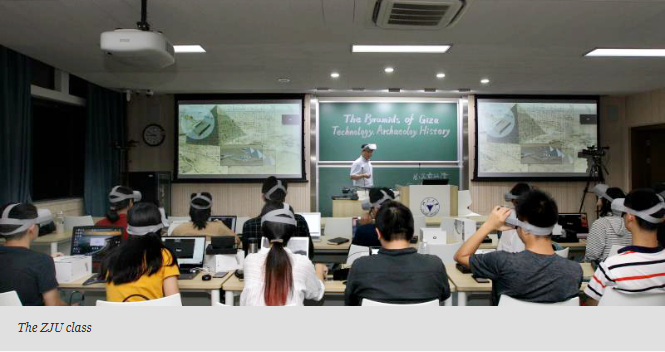ZJU pedagogical frontline - VR course with Harvard
Oct 26, 2018|hufei |
While it used to give us great amusement watching our grandfathers' jaws drop in amazement at new media teaching tools, little did we expect the very same reaction on our part at what just happened in ZJU's archaeology classroom.
On Sept. 26, ZJU students "met" their counterparts from Harvard University at "the Pyramids of Giza", benefiting from an internet connection and Virtual Reality (VR) technology.

"What an experience!" exclaimed Tansi, a ZJU Mexican student just after taking the VR device off his head. "I am walking around Giza!" He is not alone in his amazement. "While studying with Harvard students is an excitement all by itself, the lectures on recent discoveries at Giza and the best practices of excavation techniques are also great attractions." Says TIAN Zhuowei, a ZJU doctoral candidate.
The scenario above describes a joint archaeology course, "The Pyramids of Giza: Technology, Archaeology, History", originally designed by Harvard University and later introduced, owing to great efforts by DIAO Changyu, the initiator and leader of the program, to ZJU classrooms. "The class examines Giza in the context of ancient Egyptian history, art, digital archaeology and visualization," according to Harvard description of the course, "and we are delighted to be able to add students from Zhejiang University to the course by remote video conferencing."

The technology of Virtual Reality creates an immersive environment so similar to the real world that leads to a perception of physical presence. With this immersive experience, VR has long succeeded in gaming and cinema, well before education pioneers sensed its exciting potential. "Ever since I arrived at Harvard, I kept looking for the opportunity to import advanced research- and educational experience to ZJU that would benefit others besides myself," recalls DIAO, a ZJU visiting scholar in the Department of Near Eastern Language and Civilization at Harvard University, "and there I saw VR in archaeology."
Harvard’s head start in VR can be partly explained by a number of efforts. Early at the dawn of 20th century, George Reisner, the director of a joint archaeological mission from Harvard and the Museum of Fine Arts, Boston, commenced the accumulation of raw archaeological data. Later, Peter Der Manuelian, Professor of Egyptology and an avid developer of VR educational technology for archaeology at Harvard, initiated the Giza Project in 2000, and created the Giza course; he is a dedicative partner of DIAO's course-sharing initiative. In addition, gratitude is due to the technological and logistical assistance provided by the Visualization Research Laboratory of the Department of Earth & Planetary Sciences (Rus Gant, Josh Widdicombe), and by the French company Dassault Systèmes of Paris and Waltham, MA.

In the hopes of developing a long-term partnership between the two corresponding institutions, DIAO extended the Giza course informally to the ZJU campus, clearing one hurdle after another. "Time is always the biggest challenge of all," claimed DIAO.
True, very limited time was allowed for preparation prior to the start of the course in September -- interschool coordination, course selection, the need for technical support, and the time zone differences posed a number of challenges. The relatively high requirement of English language also made students hesitant about taking the course.
Yet DIAO has remained optimistic: "I am proud," he says, "that there are still 17 students from Zhejiang University who have remained in this course and are doing so well. During the last lessons, some students also initiated conversations with Prof. Manuelian and the Harvard students. I believe the ZJU students are not only learning from the Harvard course but also contributing their thoughts to it."

Members of ZJU's Cultural Heritage Institute are documenting cultural relics in Xi'an (left) and Datong (right).
Now DIAO is expecting further development of ZJU's VR course. "Zhejiang University is building a brand new VR teaching classroom. And my colleagues at Cultural Heritage Institute have spent years working on the digital documentation of cultural sites in China. We can't wait to develop a general course from those valuable data resources and we hope it will serve the students from ZJU and other universities around the world well. But teachers need to be better prepared," he cautions, "Remember, the big screen isn't just for playing films!"
Writer: XIE Qiuyi
Photo: LU Shaoqing, DIAO Changyou, Rus Gant & Cultural Heritage Institute, ZJU







